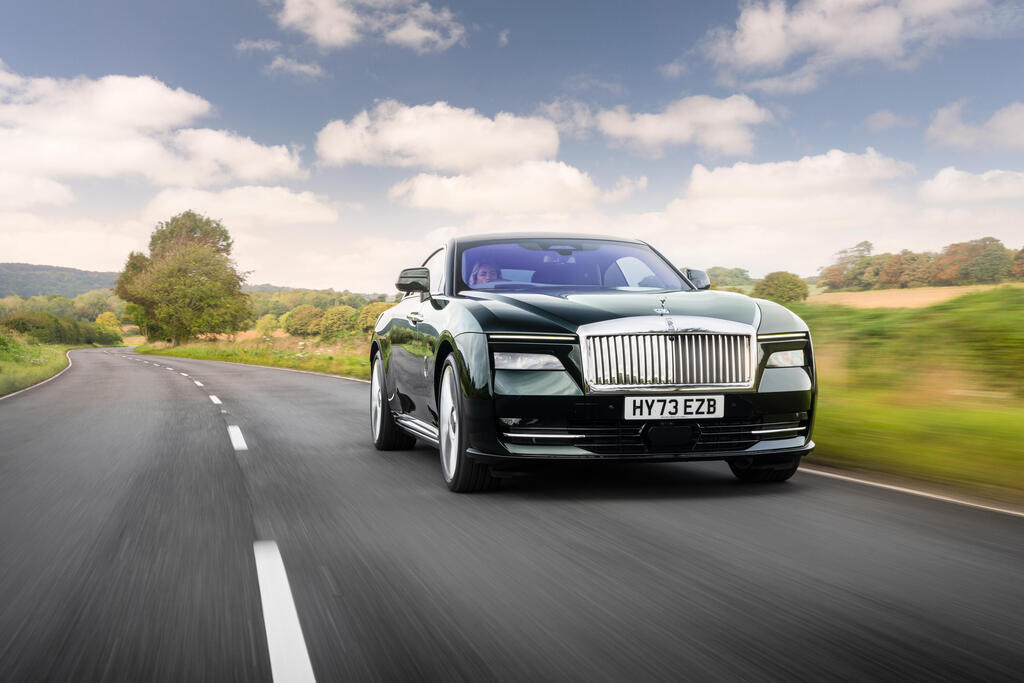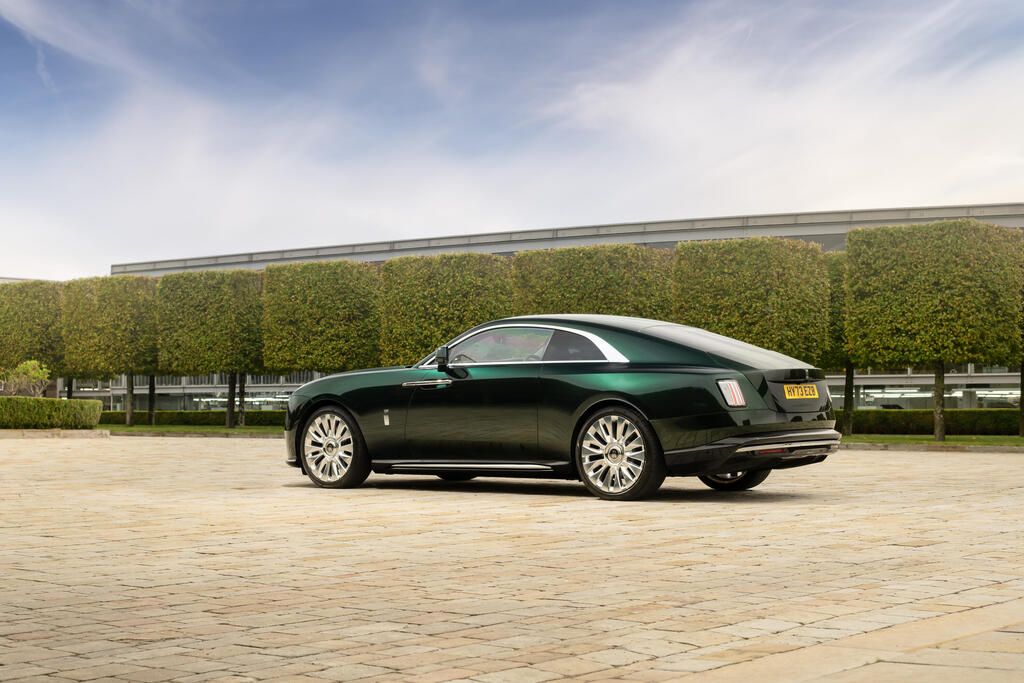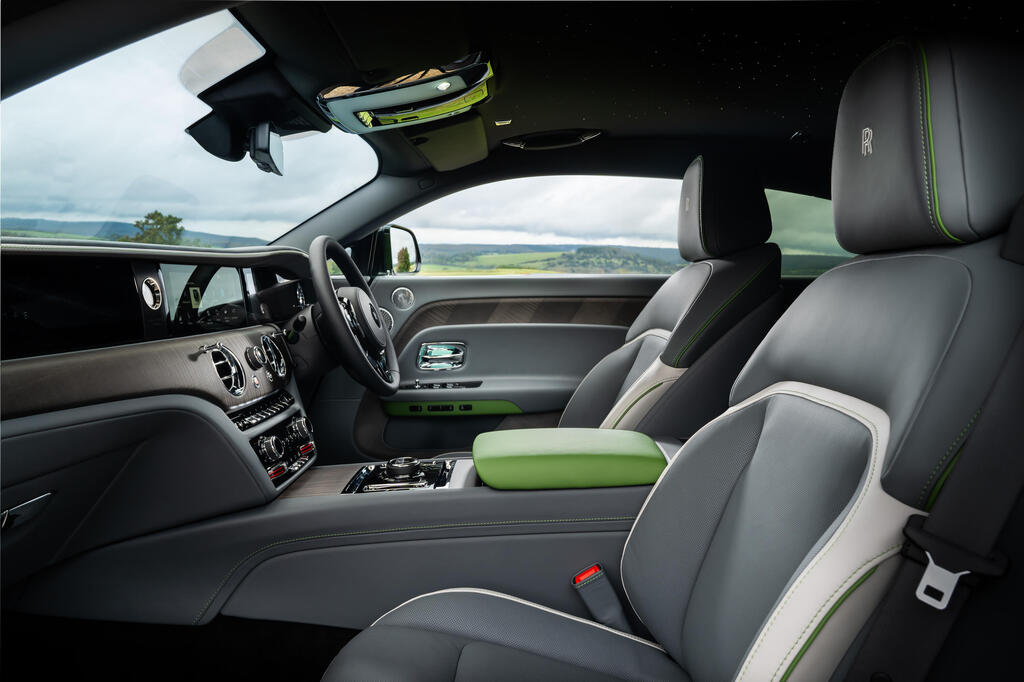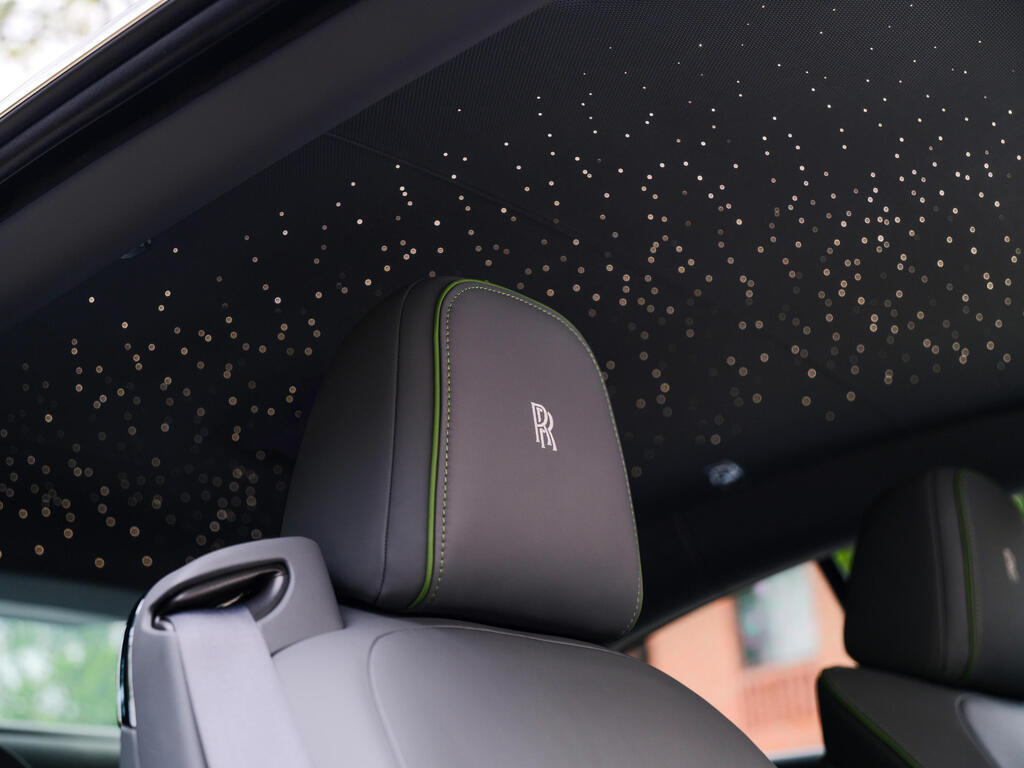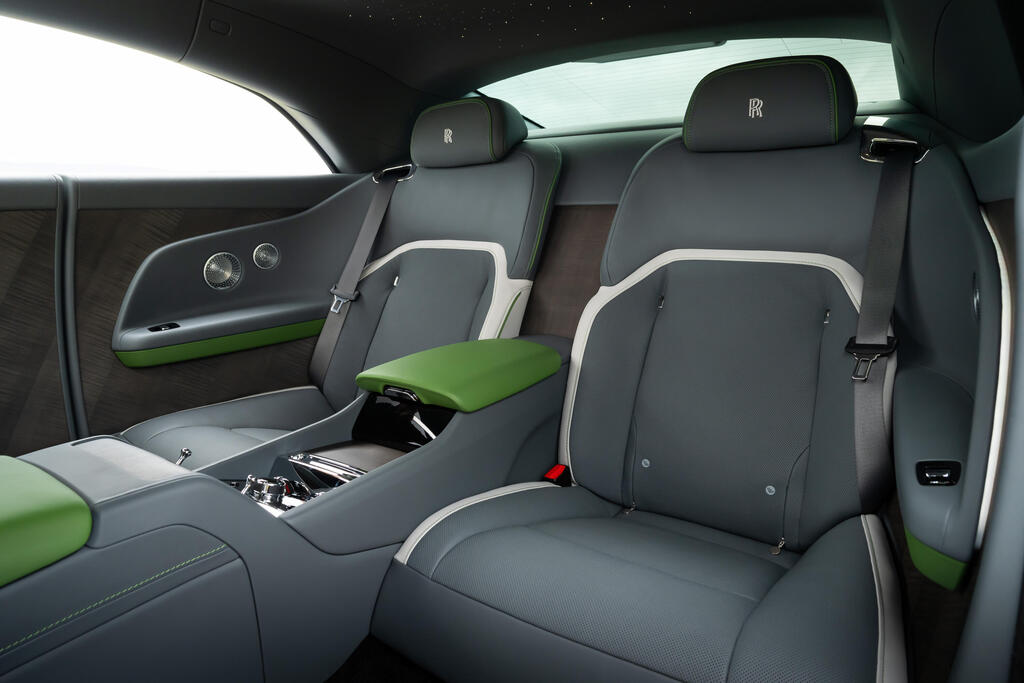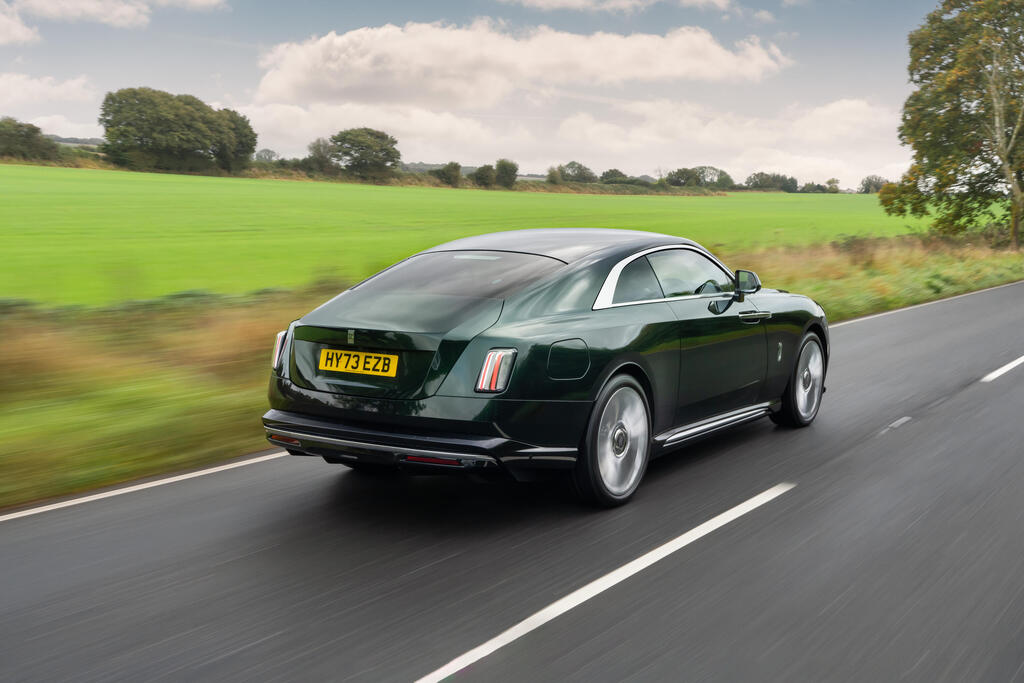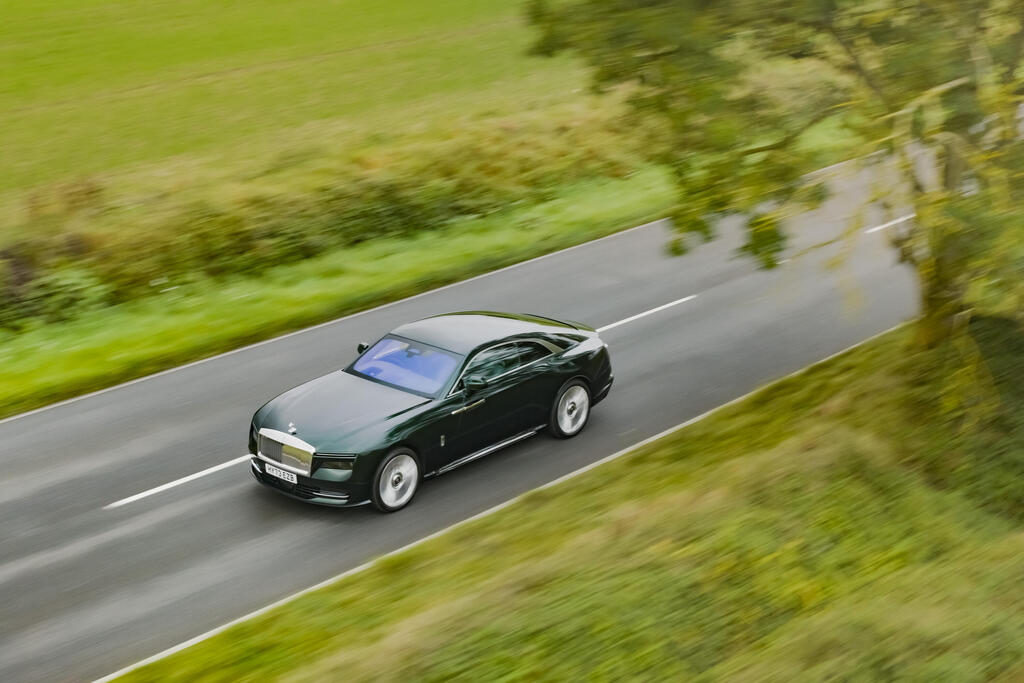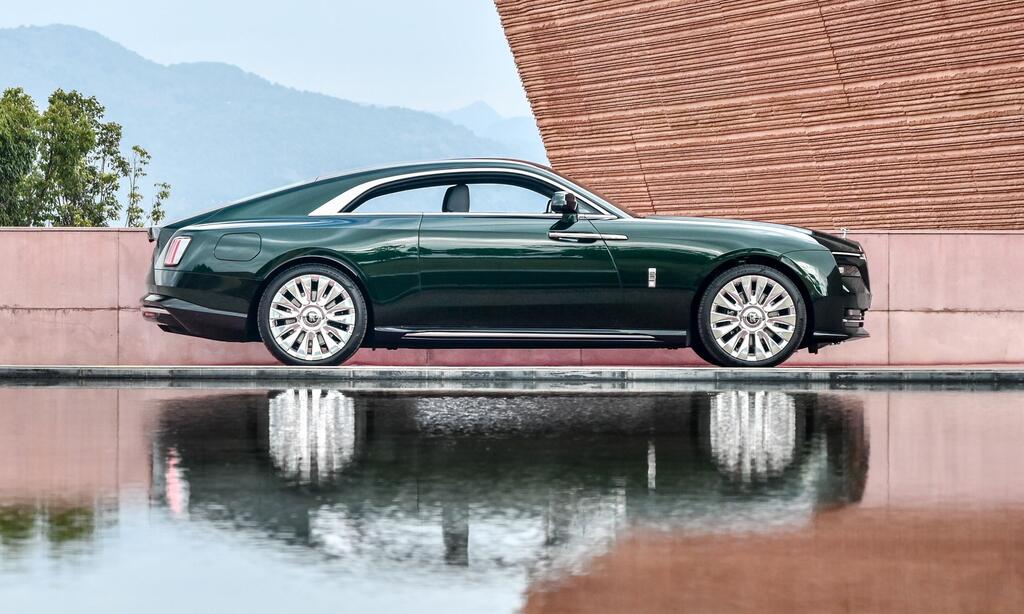- Model tested: Rolls-Royce Spectre
- Rivals: None
- Arrival in Israel: Not anytime soon
- Price: From 3 million shekels
- Pros: The best Rolls-Royce ever
- Cons: That minor issue called money
Of course, we chose a two-tone color scheme. Give us some credit. But before making a final decision, we faced a dilemma: should we go for just the hood and roof, or include the side pillars too, with the option of an additional hand-painted pinstripe along the body? It's not easy. Choosing seat upholstery alone is practically a final project. The steering wheel is available in three materials, and there are seven types of wood veneers and ten different colors for the digital dashboard. All standard for a Rolls—but not enough to justify an entire article.
Now, what about the 20 different colors available for the umbrella hidden in the door, designed to protect hair (natural, transplanted or otherwise) from a sudden autumn drizzle?
Thousands of lights and stars
Wait. You can even choose whether the Spirit of Ecstasy emblem on the hood is illuminated or gold-plated. The ceiling lining is stitched with an extraordinary number of hand-installed lights, plus exactly 4,796 LEDs (we didn't count, but we believe it) embedded in the door panels to create a breathtaking starry effect while driving at night.
And the dashboard panel in front of the passenger? It’s not just another touchscreen for entertainment and distraction, like in a Mercedes or Porsche. No. This panel incorporates a textured design featuring 5,500 illuminated "stars," along with the model name. Absolutely stunning.
Stay with me. The doors open backward, against the direction of travel—a traditional Rolls-Royce hallmark—but that's not even the most impressive detail. These are the largest doors ever installed on a Rolls-Royce, and likely among the largest on any car. Given their size and weight, and to spare the dignified owner any risk of pulled muscles or strained tendons, the doors open and close electrically. You can even close them via a dashboard button or by pressing the brake pedal, which is as cool as it sounds. And yes, there’s room for a pair of umbrellas inside—those ones you had to pick out to match your Thursday tie.
A new standard of quality
It almost goes without saying: the quality here is on another level. It’s no secret that Mercedes-Benz crafts exquisite interiors for its gasoline-powered models, with obsessive attention to materials, finish and panel gaps. Now, double that standard—and you’ll get close to what you’ll see, feel and even smell inside a Rolls-Royce.
Forget premium wood trim or brushed aluminum accents—those are found in far more ordinary cars. In the Rolls-Royce I’m currently sitting in, the floor mats are made of wool so thick and soft that stepping onto them feels like entering your parents' house after Friday cleaning, a mix of fear, reverence and barefoot tiptoeing to avoid offending Middle Eastern standards of cleanliness.
Soft, thick carpets? Check. How about a turn-signal stalk covered in leather sourced from cattle raised under optimal climate, humidity and dietary conditions, then treated through durability tests so extreme that the engineers developing the next-generation Mars shuttle in 2027 could take notes? (I’m not sure there’ll actually be such a shuttle—that’s just for illustration.)
Every switch, button, lever and dial operates with a precision that convinces you this brand really does possess a unique, almost mystical commitment to craftsmanship. And honestly, it probably does.
Electricity with class
For years, Rolls-Royce has been considered the finest automaker in the world, occupying a league of its own with no real rivals. It is no coincidence that its name has become synonymous with excellence—the “Rolls-Royce” of refrigerators, televisions, microwaves, blenders, strollers, even deodorants. And as you can tell from the flood of words above, there’s good reason for that. But there’s more.
What all Rolls-Royce models have shared until now was a massive gasoline engine in front—over the past 20 years, a rare and distinctive V12 configuration. In previous models we drove, this powerplant delivered smooth, near-silent rides with almost no vibration and plenty of force.
The Spectre, however, moves without a piston—well, except for the ones supporting the trunk and doors. It’s the brand’s first all-electric model, part of its broader strategy to phase out gasoline entirely by 2030—although given global developments, that target may be optimistic. Either way, Rolls-Royce is sacrificing a key marketing pillar: the uniqueness of its V12 engine. The electric motor here isn’t dramatically different from those found in a Tesla or BYD—heaven forbid. So what’s the plan? Invest in everything else.
Take the Spectre’s appearance, for example. Electric platforms allow for greater design freedom since there’s no need to accommodate a bulky engine, transmission and a thousand other components. Many automakers are already exploiting this, as seen in models like the Hyundai Ioniq 5, Tesla Model 3 and Smart and Zeekr vehicles.
But not Rolls-Royce. Wisely, it chose to preserve its classic look—majestic touches here and there, plenty of bling, but maintaining its iconic front end, albeit sealed and illuminated (naturally). After all, can you really imagine someone buying a Rolls-Royce and not wanting everyone to know it? Neither can we.
The Spectre proudly features the brand’s trademarks: an elongated hood and the electric-retractable Spirit of Ecstasy mascot. Officially, it's designed to deter vandals, but more likely it’s part of Rolls-Royce’s relentless pursuit of sheer spectacle. According to the company, the Spirit of Ecstasy underwent 830 hours of wind-tunnel testing to make it more aerodynamic, helping the Spectre achieve a 0.25 drag coefficient—the lowest in the brand’s history. Not that they were trying particularly hard before.
The car also rides on massive wheels, with 99% of customers opting for the optional 23-inch rims (and no, they don’t cost just pocket change). Whether you choose the standard 22-inch wheels or the larger option, the iconic RR center caps remain perfectly upright while driving, thanks to a special mechanism. After all, you wouldn’t want passengers in an ordinary Bentley wondering what just glided past them in royal silence.
All these elements come together in a rare coupé body with monstrous dimensions—18 feet from bumper to bumper. You truly have to stand next to a Spectre to grasp its scale. There’s no question of whether people will turn their heads when it passes by; the only answer is obvious. It doesn’t matter whether you're in Beverly Hills, Zurich, Milan or a trendy café on Mykonos' southern coast.
Before discussing how the car actually drives, a word about the cabin. The driver’s seat might just be the most comfortable chair I’ve ever sat in—including first-class lounges on Cathay Pacific and my sister-in-law’s fancy chaise lounge. You could spend hours or hundreds of miles behind the wheel without the slightest complaint—or flashbacks to that L3 herniated disc.
Rear passengers are hardly shortchanged, either. Thanks to the enormous 321 cm wheelbase, legroom is vast. However, possibly because of that, the trunk is modest—about 380 liters, comparable to a compact sedan. It seems optimized for carrying two lightly packed golf bags and not much more.
Flying British carpet
It’s no surprise that the Spectre delivers one of the most soothing driving experiences imaginable. So much so that luxury cars priced around a million shekels feel, by comparison, like unrefined farm equipment. The reason? With 584 horsepower and a curb weight just shy of three tons, the Spectre can move quickly. That said, it’s similar to taking a Bentley Bentayga off-roading in the Negev desert—you could do it, but you probably won’t.
Where the Spectre truly shines is when you settle into the zone—heart rate around 55, feeling momentarily detached from the chaotic world outside. The lightweight steering never feels too light, the soft pedals never feel mushy and every action, from adjusting the whisper-quiet climate vents to opening a hidden storage compartment, feels effortless. It’s the perfect car to unwind in after a tense board meeting—or after another Manchester United loss, which happens more often these days.
The car is powered by two electric motors—258 horsepower in front, 489 at the rear—propelling this heavyweight from 0 to 100 km/h in 4.5 seconds. Until recently, that was Porsche 911 territory. And it does so in near-absolute silence, delivering smooth, uninterrupted acceleration from 10 to 210 km/h. Even the faint whirring typical of many EV drivetrains has been eliminated thanks to heavy insulation and double-glazed windows.
For those who must have it, Rolls-Royce offers an optional synthetic "engine sound" played through the speakers. It’s a bit like pouring cola into a glass of cognac. Once you disable it, you’ll discover that at 130 mph, the Spectre is quieter than most luxury cars are at 60.
A massive 102-kWh battery theoretically allows for a range of 530 kilometers—more than enough for the company president’s commute from home to headquarters (though for longer trips, he’ll likely prefer his private jet). Along the way, he would miss out on one of the most impressive suspension setups available, combining air springs with active anti-roll bars that stiffen or soften based on steering, acceleration and real-time road scanning. Naturally, rear-axle steering is also included, providing nimble handling without the artificial feel found in other systems.
The Spectre rides so smoothly that clichés are hard to resist. So here it is: it’s a flying carpet.
The queen of electric luxury
After a day of hundreds of miles behind the wheel—feeling like the king of the world and casting a pitying glance at every "ordinary" new Mercedes S-Class—the question arises: does this Rolls-Royce justify a price tag that could buy nearly three BMW i7s?
Electrically speaking, it’s not particularly groundbreaking. There’s no revolutionary fast charging, no previously unheard-of technologies. In fact, compared to others, the Spectre is almost minimalistic in its tech offerings.
So, is it worth it? Rationally, no. But no one buys a Rolls-Royce for rational reasons. People buy it for ego, agency, status, presence—everything but reason. And therefore, the only possible answer is a resounding, indisputable yes.
Get the Ynetnews app on your smartphone: Google Play: https://bit.ly/4eJ37pE | Apple App Store: https://bit.ly/3ZL7iNv
After a full day of driving, it becomes clear: the difference is in the execution, and it’s massive. Like its gasoline-powered siblings, the Spectre feels like it belongs to an entirely different league of craftsmanship and refinement. The ride comfort is out of this world, making it arguably the most comfortable car ever built.
One final note: most traditional luxury brands have failed to maintain their standards in their shift to electric. The Mercedes EQS does not match the excellence of an S-Class. The Porsche Taycan can’t touch the driving dynamics of a 911. But Rolls-Royce took a different path. In the Spectre, electrification enhanced rather than diminished the brand’s DNA. Sure, we miss the soul of a V12, but honestly, not that much.
Because the Spectre might just be the finest Rolls-Royce ever made.
Technical specifications:
Motor: Dual electric motors
Battery: 102 kWh
Power / Torque: 584 hp / 91.8 kgm
Drive: All-wheel drive
Length: 547.5 cm
Width: 201.7 cm
Height: 157.3 cm
Wheelbase: 321 cm
Weight: 2,890 kg
Trunk capacity: 380 liters
0-100 km/h: 4.5 seconds
Top speed: 250 km/h
Airbags: 8
Safety rating (Euro NCAP): Not yet tested
Price: From 3 million shekels


